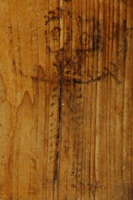
 |
|
 |
| Home |
| Background |
| Curriculum |
| The Schoolhouse |
| Teachers & Students |
| Apprenticeships |
| Artifacts |
| The Gymnasium |
| UM Papyrology Home |
| References |
| Credits |

In Graeco-Roman Egypt, there was an
important social/educational institution known as the 'gymnasium'. The
gymnasium had a very long pedigree, dating back in Greece to at least
to the 6th century BCE. The Greeks believed that a sound body was as
important to one's well-being as a sound mind, and the original gymnasia
were places for young men to exercise and train for sporting contests.
(The root 'gymnos' means 'naked', which reflects the fact that ancient
Greek athletes worked out in the nude.) Over time, however, the gymnasium
developed into more and more of a social club, where teenage boys, or
'ephebes', would be educated in cultural behavior by older men. |
||
|
The Gymnasium at Pompeii (Italy). The amphitheater is visible in the background. This is one of the best preserved gymnasia from the ancient world. |
|
In Ptolemaic Egypt, the gymnasium's role expanded even further. At age fourteen, boys (and occasionally girls) who could prove that they had Greek ancestry on both sides of the family were enrolled in the gymnasium. The gymnasium was the key to social advancement. It was there that one met other up-and-coming young adults, practiced athletics, learned military training, and also studied more advanced academic material, such as rhetoric. The gymnasia hosted lots of festivals, and were the center of Greek life in the city. Archaeological excavations show that gymnasia were typically large open squares surrounded by rooms and colonnades, and could often be very ornate. In the Roman period, the number of gymnasia declined, as they were mainly found in the large regional capitals, or metropoleis. The Romans had a different system for determining status than the Ptolemies- instead of Greek ancestry, one had to show sufficient family wealth and belong to a certain social class. Nevertheless, they remained important centers for youth to socialize and develop contacts. The degree to which gymnasia served as academic institutions is debated. In Athens, the great academies of Plato and Aristotle grew out of gymnasia, and they were very much involved in rhetorical and philosophical training. Visiting scholars might give lectures, and there were even art exhibits and concerts. However, these were not typical schools. Archaeologists have noted that excavated gymnasia in Egypt lack libraries or classrooms. Common sense suggests that all these gathered teenagers would probably receive some sort of academic instruction, but our documentation doesn't tell us very much about how the gymnasia functioned in this regard. |